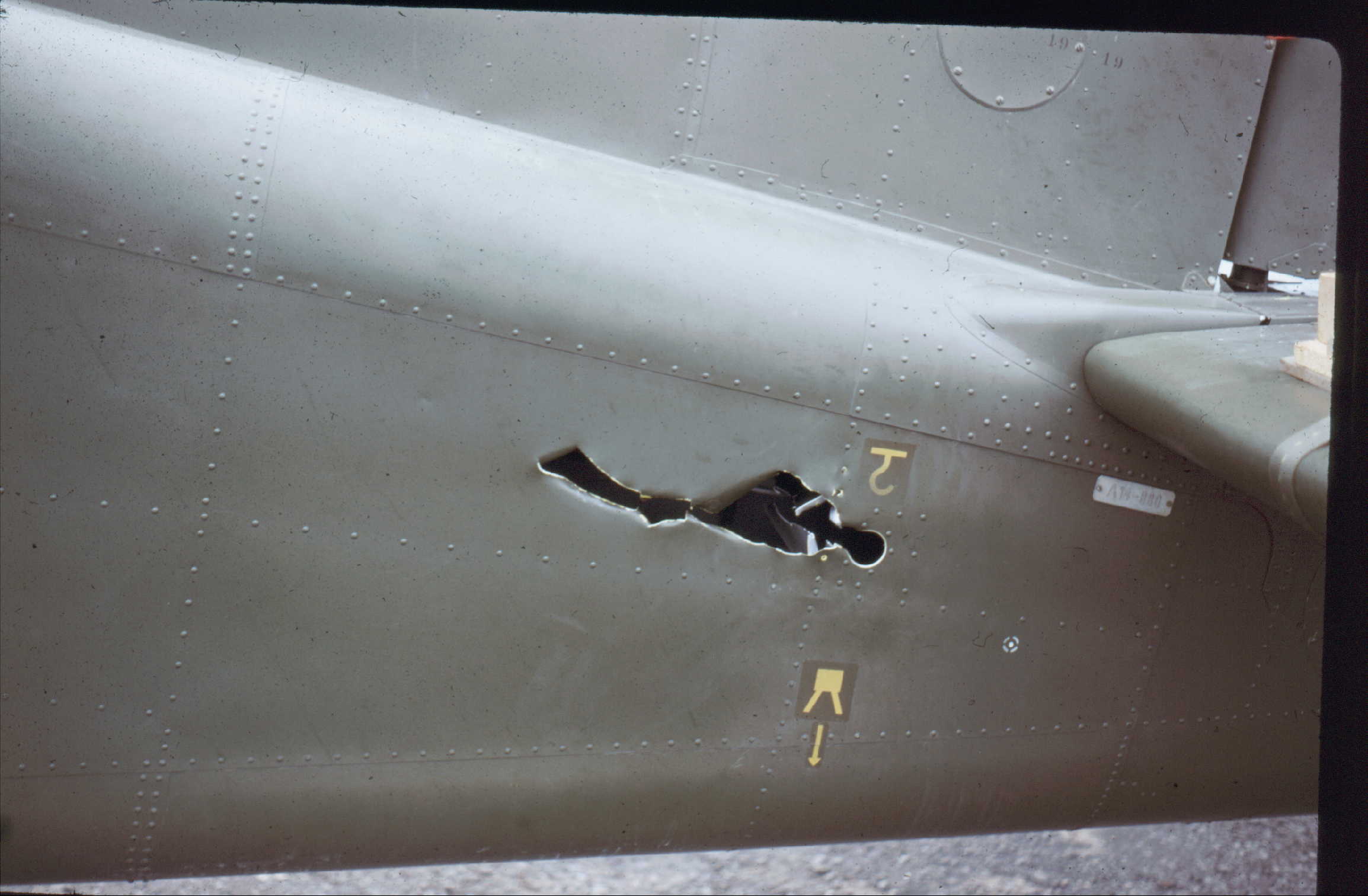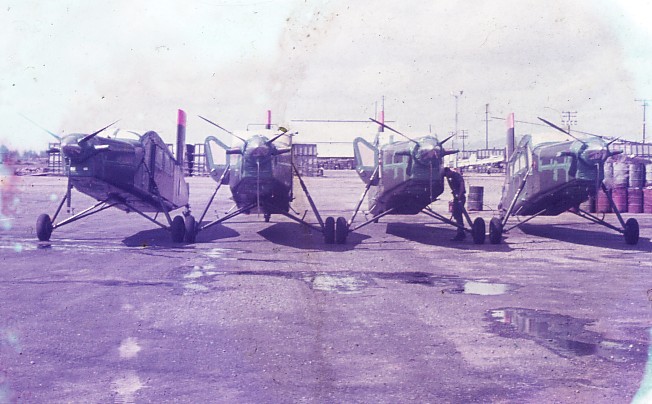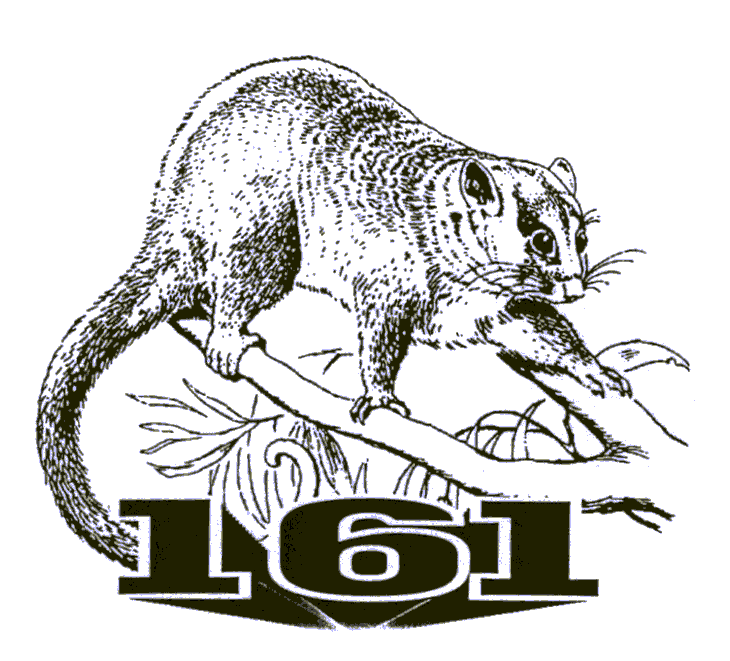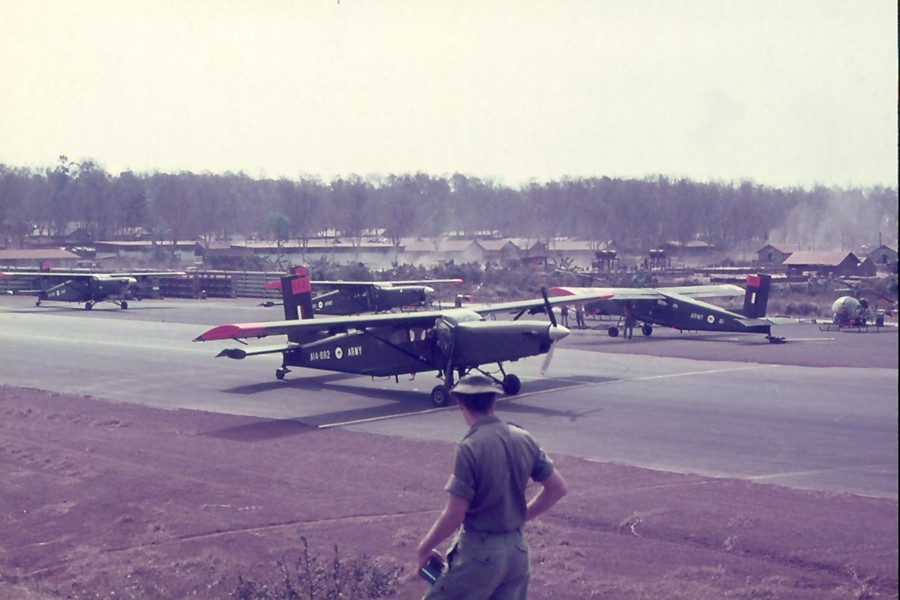|
|||||||||||||||||||||||||||||||||||||||||||||||||||||||||||||||||||||||||||||||||||||||||||||||||||||||||||||
|
|||||||||||||||||||||||||||||||||||||||||||||||||||||||||||||||||||||||||||||||||||||||||||||||||||||||||||||
| Basic Weight | 3,100 lbs | Max cruise speed | 118 knots |
| Max all-up weight | 4,850 lbs | Minimum cruise speed | 70 knots |
| Range | 300 nautical miles | Fuel | JP1 or JP4 Avtur |
| Endurance | |||
| Normal cruise | Max 180 minutes | Economic cruise | Max 210 minutes |
![]() November 1969 - Vietnam.
November 1969 - Vietnam.
Only six of the 19 Pilatus Porters that the Australian Army owned were deployed to South Vietnam with 161 (Indep) Recce Flt.
The aircraft that were sent to Vietnam were A14-680, -681, -686, -690, -692 and -701.
The first three aircraft to be sent to Vietnam were A14-680, -681 and -686. They travelled to Vietnam aboard HMAS Sydney and they arrived at Vung Tau on 28 November 1969. Accompanying the aircraft on there journey were two new members of the Flight, Lt Damien Aird (Fixed Wing Pilot) and Cpl John Crawford (Engine Fitter).
The transfer of the first aircraft (A14-680) from HMAS Sydney to Nui Dat did not go without problems. The transfer involved lifting the Porter off the ship using a "special jig" and a US Army Chinook and delivering the Porter to the Flight at Nui Dat. However, the rotor wash caused by the Chinooks main rotors down onto the tail-plane of the Porter was so great that the rear "tie down lifting bar", at the rear of the Porters tail-plane, tore through the skin section of the tail-plane and caused considerable damage to the aircraft.

Although there was obvious concerns of causing further damage to the Porter and possibly the Chinook the task was completed and the Porter was delivered to Nui Dat however, the damage caused to the Porter kept the aircraft grounded until the end of December.
The other two aircraft were off loaded onto barges from the ship onto the wharfs at Vung Tau and then towed to the Vung Tau Airfield where they were reassembled by members of 161 (Indep) Recce Flt. The aircraft were subsequently flown forward to Nui Dat. Both aircraft had to have acceptance servicings and as soon as they were cleared for flight they began familiarisation flying in the local area.
Unfortunately disaster struck after only a few days when A14-686 was shot down and destroyed on 03 December.
Barry Donald was the pilot of the aircraft and Alan Jellie (helicopter pilot) was his passenger. The aircraft had been flown through the day and was on the first night flying familiarisation flight of a Porter, in Vietnam. As they were returning to Nui Dat at approx 2200hr, they received ground fire as they flew over the Bhin Ba Rubber Plantation. The aircraft crash landed at the edge of the rubber plantation after clipping some rubber trees, both pilots were killed. The aircraft was extensively damaged from the crash and a fire that had broken out in the aircraft.
A replacement aircraft was called forward from Australia. A14-690 was subsequently transported by road to RAAF Base Richmond and delivered to Vung Tau Airfield by RAAF C130 Hercules on 20 or 21 December. After being reassembled by members of 161 (Indep) Recce Flt Wksp, A14-690 was test flown by Major Graeme Hill-Smith, OC 161 (Indep) Recce Flt, on 22 December and subsequently flown to Nui Dat. The next recorded flight for A14-690 in Vietnam was on 3 January when Major Hill-Smith test flew the aircraft following an acceptance service and detailing for operational service in Vietnam.
A14-680 was sent home to Australia and replaced by A14-701 in May 70. A14-701 arrived at Nui Dat aboard a RAAF C130 Hercules. The reason for 680 being sent home, after only being in country for less that five months, is not known.
A14-692 arrived in country in January 1971 increasing the number of Porters in the Flight to four.
Aircraft Numbers and Dates of Service of Porters in Vietnam
| Aircraft Serial No | Dates Aircraft in/out of 161 | Vietnam Service and Current Aircraft Status |
| A14-680 | 29 Nov 69 to May 70 | May 70 - returned to 1 Avn Regt at Amberley QLD. |
| Cat 5 - Weipa - QLD - 21 Sept 81. | ||
| A14-681 | 29 Nov 69 to Feb 71 | Feb 71 sent to Air America in Saigon for E Service. |
| Mar 71 to 02 Jan 72 | Jan 72 - returned to 1 Avn Regt at Amberley QLD. | |
| CAT 5 - Oakey - QLD - 28 Nov 80. | ||
| A14-686 | 29 Nov 69 to 03 Dec 69 | CAT 5 - Vietnam - Pilot - Barry Donald (03 Dec 69). |
| A14-690 | 22 Dec 69 to Mar 71 | Mar 71 sent to Air America in Saigon for E Service. |
| 05 Apr 71 to 02 Jan 72 | Jan 72 - returned to 1 Avn Regt at Amberley QLD. | |
| November 1992 this aircraft was allocated to the Australian War Memorial in Canberra for Static Display. | ||
| A14-692 | Jan 71 to 03 Nov 71 | Nov 71 flown to Air America in Saigon for E Service. |
| 21 Nov 71 to 02 Jan 72 | Jan 72 - returned to 1 Avn Regt at Amberley QLD. | |
| CAT 5 - Buckambool NSW - 23 Mar 77. | ||
| A14-701 | May 70 to 17 May 71 | May 71 flown to Air America in Saigon for E Service. |
| Jun 71 to 02 Jan 72 | Jan 72 - returned to 1 Avn Regt at Amberley QLD. | |
| 1993 - Sold to Pilatus Switzerland. | ||
![]() Roles for the Porter in Vietnam.
Roles for the Porter in Vietnam.
The Pilatus Porter was operated in a diverse range of roles in Vietnam and they ably demonstrated their exceptional capability in all taskings. The roles that the Porters were used for included the following:
|
Liaison and Air Courier Services |
Command and Control |
| Psychological Operations - Leaflet Drops and Voice Ops | Battlefield Flare Illumination Missions |
| Electronic Surveillance - Enemy Location | Radio Re-broadcasting |
| Passenger and Road Reconnaissance | Air Photography |
| Carriage of Freight / Personnel | Rocket Ground Attack |
| RW Top Cover Missions | Target Marking and AOP Missions (Naval and Army) |
Whilst in Vietnam the Porters flew a total of 8,053 hours and 6,987 sorties.
![]() Major Servicing in Vietnam by Air America.
Major Servicing in Vietnam by Air America.
The cost and down time incurred in sending the Porters back to Australia for the routine major servicings was substantial. Therefore, instead of sending the Porters back to Australia, arrangements were made for the servicings to be done by Air America at their facilities at Tan Son Nhut Airport, Saigon. Only four aircraft required servicings and aircraft details and dates of the servicings are as follows:
| Acft No. |
E Servicing Dates |
| A14-681 | Jan - 12 Feb 71 |
| A14-690 | 22 Mar - 05 Apr 71 |
| A14-692 | 03 to 21 Nov 71 |
| A14-701 | 17 May - Jun 71 |
![]() Going Home.
Going Home.
With the decision made that all Australian military forces were to be withdrawn from Vietnam, 161 (Indep) Recce Flt began preparing the move from Nui Dat to Vung Tau and this task was completed on 05 October. The Flight remained fully operational in support of 1ATF throughout the move.
A plan to fly the Porters home to Australia had been approved, however that approval was withdrawn in October and alternate means of getting the four aircraft home had to be found. Unfortunately, there were not many options available for the return of the aircraft because all available space on Australian ships/aircraft had been allocated to other units.
Space for the Porters to be transported back to Australia was subsequently found on a Japanese Freighter.
The last operational flight of a Porter in Vietnam was carried out on 13 Dec 71, after which the Porters were removed from service and prepared for their eventual return to Australia in early Jan 72.

On 1 Jan 72, the RAEME element of the Flight towed the four Porters from Vung Tau airfield down to Do Long Pier, where they were loaded aboard the "Harima Maru" for the trip home to Australia.
![]() Post Vietnam Service/Disposal.
Post Vietnam Service/Disposal.
On arrival back in Australia the four Porters were absorbed into the Army Aviations Fleet of Porters and were subsequently dispersed throughout the units which operated the Porters.
The Pilatus Porters remained in service with the Australian Army Aviation Corps until 17 October 1992, when the aircraft were officially retired from service and were listed for sale.
During the life of the Porter with the Australian Army, seven aircraft were destroyed. This left 12 aircraft available for disposal in 1992. Ten (10) aircraft were sold. Six of those aircraft sold were purchased by Pilatus Switzerland in early 1993, dismantled and shipped overseas. Four aircraft were purchased for service in Australia, however one of these aircraft was resold to a buyer from Canada.
The remaining two Porters were retained in military markings for preservation in Australia. A14-690 was allocated to the Australian War Memorial in Canberra for eventual static display while A14-652, the first Australian Army Porter, was allocated to the Museum of Australian Army Flying (MAAF) to be retained in flying condition. In addition, A14-704 which was being held by the MAAF after it crashed in 1990, is being retained as a static display at the MAAF.
|
Other aircraft: Bell 47G-3B1 Sioux Helicopter | Cessna 180 | Bell OH58-A Kiowa Helicopter | Birddog | Bunny II |
_______________________________________________________________________________________________
[Return
to Top]

